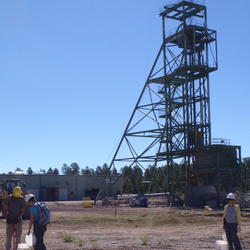Exposure to Minerals
Exposure to Minerals
Filter Total Items: 8
Behavioral Toxicology Core Technology Team
About the Research. The Environmental Health Program supports scientists in the Behavioral Toxicology Core Technology Team (CTT) at the Columbia Environmental Research Center. The scientists identify how contaminants alter the behavior of organisms and what implication those changes may have on individuals, populations, and communities.
Technique Used to Distinguish Natural Background from Human-Caused Enrichment of Trace Elements in Soils
Human activities can enrich toxic trace elements like uranium and arsenic in the environment, but these elements also are from natural sources and occur at background levels. Scientists utilized a technique that identifies the background and the elemental fingerprint of human-caused enrichment and tested the new technique on data collected near uranium mines in Arizona.
Is Uranium in Water Resources near the Grand Canyon a Health Hazard?
The public is concerned that uranium in natural geologic formations, mine tailings, dusts, water, and other geologic materials can pose a health hazard to humans and wildlife. Our specialized teams of hydrologists, chemists, and geologists working together at a field site in the Grand Canyon region of the United States have shown: Elevated uranium concentrations (above the drinking water standard)...
Can There be Unintended Benefits when Wastewater Treatment Infrastructure is Upgraded?
Science from the U.S. Geological Survey (USGS) and other entities has shown that a mixture of natural and synthetic estrogens and other similar chemicals are discharged from wastewater treatment plants (WWTPs) to streams and rivers.
Minerals Science Team
The Minerals Integrated Science Team focuses on contaminant exposures in the environment that might originate from mineral resource activities including, transportation, storage, extraction and waste management. Perceived health risks to humans and other organisms will be distinguished from actual risks, if any. If actual risks are identified the science produced by this team can inform how to...
Environmental Chemistry Core Technology Team
About the Research The Environmental Chemistry Laboratory Core Technology Team (CTT) as part of the Environmental Health Program develops and applies innovative methods of sampling and analysis to answer critical questions about the occurrence, distribution, fate and transport, and biological exposure of chemical in all environmental matrices (water, air, tissues, sediments, and others).
Fish Diets Switch From Aquatic to Terrestrial Insects in Streams Effected By Metal Contamination
A riparian zone rich in terrestrial insects can provide an alternate food source for fish in metal-impacted watersheds.
Metals in Acid Mine Drainage Affect Aquatic Insects
Studies conducted in subalpine streams in Colorado by U.S. Geological Survey (USGS) scientists found that aqueous metals resulting from acid mine drainage and natural weathering can almost eliminate adult insect emergence from streams, even at metal levels too low to reduce aquatic larval densities. This pattern suggests that adult insects might be a more sensitive indicator of metals than...








